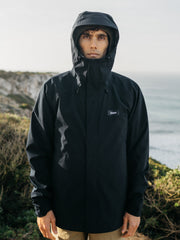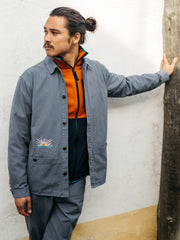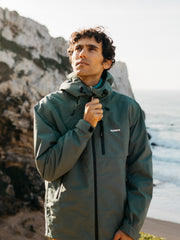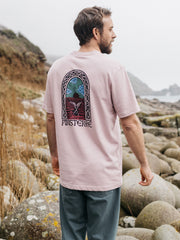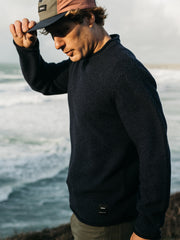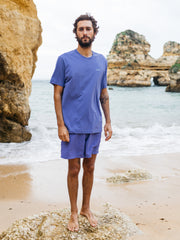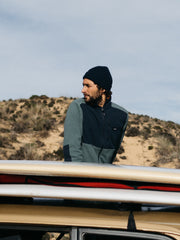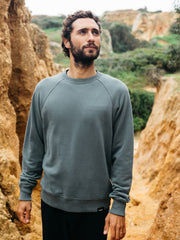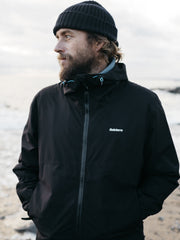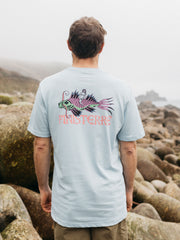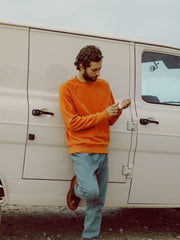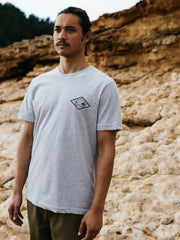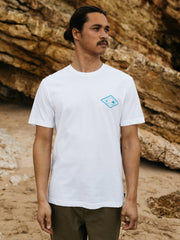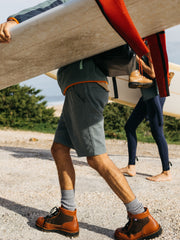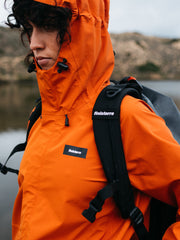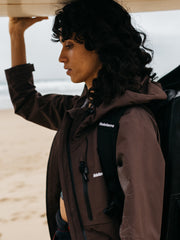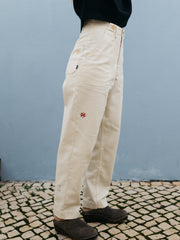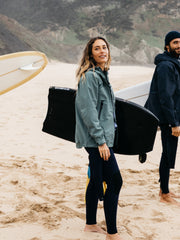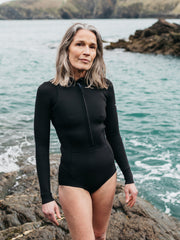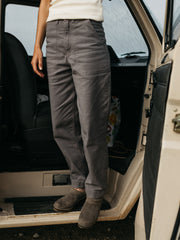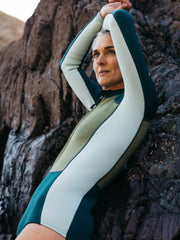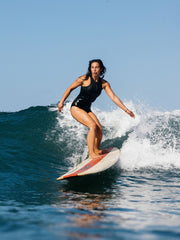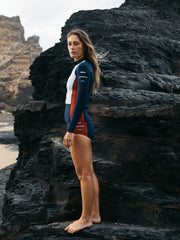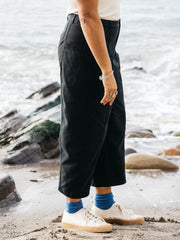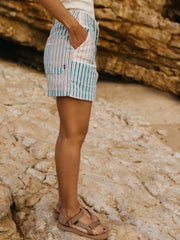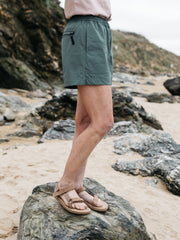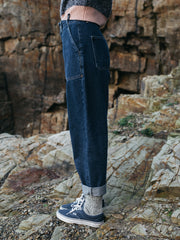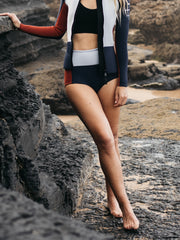Regular readers of the Broadcast, may remember Dr Lou Luddington and her husband Tom. Having sold their house in Wales and the majority of their belongings to become permanent liveaboards, the novice sailors set out on their first ever Atlantic crossing. Fair sailing was predicted. The ocean did not oblige.
If you missed it, catch up on their story so far here.
The Crossing Pt. 1
10.08.22
5 min read
Words & Photography by Dr Lou Luddington
For some it’s a leisurely, joyous affair of escapism, with fair winds, minimal swell and a few windless days thrown in allowing a mid-Atlantic swim and endless wildlife spotting. For others it's a wild and burly ride of mid-ocean surfing in howling winds, sleep deprivation and fearing for your life. We planned for the first scenario but got the second.
On November 22nd 2022 we set off from El Hierro in the Canary islands to sail across the Atlantic to the eastern Caribbean aboard our 35 foot sailboat home Noctiluca. Spanning 2,500 nautical miles we had calculated a passage time of around 3 to 4 weeks. Acknowledging the magnitude of such a journey we invited our good friend Sergio to help us crew. This would be our first trans-Atlantic crossing, and by far the longest passage any of us had undertaken. It would prove to be far more epic and challenging than we ever imagined or wished for. With a catalogue of serious breakages and relentlessly testing conditions it became a life experience that was at times harrowing and others utterly exhilarating.
After more than a year of preparations, provisioning the boat with a month's supply of food and feverishly consulting a range of weather forecasts, sailing friends and relatives as well as weather forecasting experts, we set off on a Tuesday morning into a lively sea. We knew it would be a windy start to the journey but the long-range forecast promised it would calm down in a few days to conditions that would provide the text book crossing. This was our weather window. Yet the wind and sea state we experience even in that first hour of our journey are significantly stiffer and chunkier than we expected.
Lou, above deck...
... and Tom, below.
Pointing west with the last sight of land vanishing behind us we feel the raw energy of open-ocean. The wind rises, peaking at 35 knots and we roll deeply from side to side on the swell. For the next 24 hours we get brutalised as we negotiate 4 metre swell and unforecast gale force winds. Life aboard Noctiluca becomes a rollercoaster; for every waking and sleeping moment of our days we are in motion. We begin a routine where days and nights are made up of 3 and 4 hour shifts that wreak havoc with our sleep patterns but provide welcome structure to our days. This always leaves one person in charge of steering and sailing the boat whilst the others sleep, rest, do chores, read, take ablutions and cook. We each do our share of ship duties but as Captain, Tom feels the weight of every decision made and problem encountered. On day 3 we are tested to the brink.
Day 3...
As I ready myself to begin my shift and take over from Tom, he calls down from the cockpit that we need to reef the genoa (make the big front sail smaller), then suddenly, more urgently, “we need to get the whole thing in, NOW.” I race up the companionway steps and get into position “It's going to be hard but we have to do it. There's something not right with the bowsprit, it's flexing “ Tom says. I look forward to see the genoa furler wobbling about and the whole bowsprit bending up at the tip. Something serious is wrong. We manage to furl the genoa away and Tom goes forward secured by his leash to assess the damage. He finds the bobstay dangling in the water dragging the broken chain plate that should hold it onto the bow. This cable provides forward tension, not only holding the front sail, but also supporting the mast. Without it the mast could come down. To be dismasted in the middle of the Atlantic Ocean is to be in serious peril.
Tom & Sergio jump into action to fashion a repair...
... No mean feat, dangling from the bow in heavy seas.
Tom and Sergio work hard up at the bow to fashion a repair, not an easy task dangling from the furthest reach of the boat as it surges wildly through the waves. Tom lies prone on the bowsprit, arms reaching down to reattach the cable somehow. At times it plunges to meet the water so that his chest dips into the waves; it’s delicate work with tools and loose parts while clinging on so as not to fall. As usual his problem solving and tenacity to find a solution is heroic. Motivation levels are high and adrenaline charged; to fail risks catastrophic damage to the boat.
Tom realises that we should check inside the boat at the attachment point for leakage in case there is damage to the hull. We discover the bilge is awash with water and fear the worst. On further inspection it turns out that by coincidence our fresh water supply has sprung a leak. We are not sinking but have lost 100 litres of fresh water into the bilge.
Over the next hours and days we secure the mast with a spare halyard and monitor the bow repair as it fails three times under the strain of the hefty sea conditions. We resign ourselves to not being able to use the genoa for the remainder of the journey and are glad to have a cutter rigged boat with a second smaller stay sail to hold up the mast. Weighing up our options we consider diverting to the Cape Verde islands, 5 days away, but decide the safest choice given the wind conditions is to maintain our current course downwind to the Caribbean. It's a big decision but with agreement from Tom’s brother on the satellite phone, we are unanimous. Spirits are low and conditions are tough. Through the night waves thump and wallop the hull and we each imagine the mast toppling in the darkness.
After two days sailing with just the small stay sail the wind eases a little so we decide to raise the mainsail in an attempt to temper the violent rolling motion of the boat. We start the engine and turn into wind only to discover that the impeller has disintegrated blocking the cooling water to the engine. Without cooling water the engine would quickly overheat, so we kill the engine and turn back downwind. Once we locate and remove the broken pieces from the pipes, a spare impeller is swiftly fitted and we are back in action. The next challenge follows close behind though when minutes later the steering cables detach themselves so that I lose all control of the boat. Much to Tom and Sergios dismay this is a far more long-winded repair requiring some head-first contortionism in the back locker to reach the steering mechanism. After 5 hours they prevail and celebrate a double win amidst a growing list of unexpected demands. Having the triple reefed mainsail up does help, and we continue the rollercoaster ride down wind...


